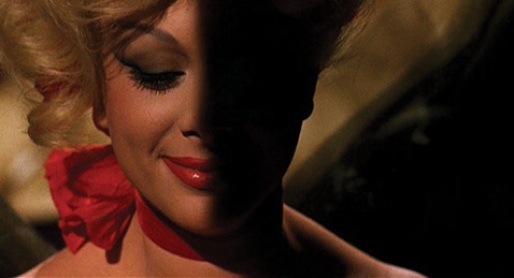If “Juliet of the Spirits” is Fellini’s love letter to his wife Giulietta Masina, then it is the strangest love letter ever made. This remarkably surreal film with its haunting spectral beauty is a deliciously maddening portrait of love as seen through an other worldly lens of spirits, memories and religious symbolism.
A number of critics sight this film as the start of Fellini’s decline as a filmmaker, saying that “Juliet of the Spirits” lacks the autobiographical poignancy of his masterpieces “La Dolce Vita” and “8 1/2.” “Juliet of the Spirits” was made right after “8 1/2” in 1965, and it’s been said that this film is so frustrating because it feels like Fellini is going on autopilot with half baked visuals and symbols designed precisely to recall his previous films.
Yet Fellini just running on autopilot is a thousand times better than hundreds of other directors working at full capacity, and “Juliet of the Spirits” is so affecting because despite all the criticisms, it remains remarkably exotic, strange, nonsensical and yet all so infectious.
Fellini is possibly the most lovable and accessible of all the famous art filmmakers because his films are so alive with playful caricatures and circus grotesqueness. Yes his avant-garde montage through a lavish mansion decorated like a brothel is a sultry, suggestive and chilling ordeal, but Fellini is more than willing to staple that image beside the giddy oddity that is two little girls in white dancing to Nino Rota’s spastic score.
Rota blends the sounds of organs, horns, flutes, clarinets and every other musical oddity to create the appropriate sound to fit Fellini’s many moods. It makes even the most ordinary scenes (if there are any in this film) eerie, perky, playful and more.
And for critics to even suggest that Fellini’s first film in color could possibly be him operating on autopilot is sorely mistaken. Everything about “Juliet of the Spirits” is vibrant with color and alive with movement. The film has too many drop dead gorgeous visuals and memorable shot placements to count, each one nothing less than stunning in their beauty. So much occurs on screen at once, and yet Fellini’s camera dances and soars slowly and gracefully. His coy use of lighting to reveal or hide faces is no accident. Every move he makes contributes to the film’s mysticism and fluid sexuality.
And I agree with Fellini’s optimistic view over Masina’s melancholy one when I view the film’s ending. For something as wide open and shimmering as the film’s last few shots, it can suggest nothing less than a victory of overcoming bad memories and demons and embracing the freedom of life.
This brighter view of life puts me on the side of Team Fellini in the old war between him and Antonioni. He made films that, even if they did contain cynical or haunting overtones, made you thrilled and happy to explore them.
